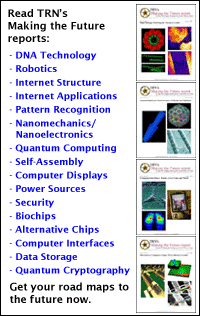
Quantum crypto scheme doubly fast
By Eric Smalley, Technology Research NewsQuantum cryptography uses the quantum properties of light to transfer information in a way that can be perfectly secure. Today's quantum cryptography systems transfer information relatively slowly, however.
Researchers from the Australian National University and the University of Queensland in Australian have found a way to double the speed of information transfer over quantum cryptography systems.
The technique can simplify and increase the bandwidth of most quantum cryptography schemes, said Ping Koy Lam, a reader in physics at the Australian National University.
Quantum cryptography systems generate a secure key that people in separate locations can use to encrypt messages to each other. The key can be sent over an unsecured line because the 1s and 0s of computer information are represented by the properties of photons in such a way that the sender and receiver can tell if an eavesdropper has peeked at the key.
Photons can be measured in one of two ways, or bases; each type of measurement can encode a bit of information. If a photon is encoded in one way and measured in the other, the bit is lost because the photon can only be measured once.
At the heart of traditional quantum cryptography techniques is the practice of randomly switching between bases. Switching occurs when the sender, for example Alice, encodes the bits and when the receiver, for example Bob, measures them. Bob tells Alice which basis he used for each bit and she tells him which he chose correctly. "By randomly switching, Bob would confuse any eavesdropper... who would only measure the right basis half the time," said Lam. "This was thought to offer the necessary condition for security in all previous quantum cryptographic protocols."
The Australian researchers showed that a particular step in standard quantum cryptography protocols -- switching -- is no longer necessary. Not having to switch doubles the speed of information transfer.
The researchers' method involves using a multi-photon, or continuously variable, quantum cryptography scheme, which taps the quantum nature of laser pulses' amplitude and phase rather than using an attribute of single photons to store bits of information. Lasers are quantum devices because their photons flow in lockstep. These devices provide stronger signals and potentially faster data rates.
Under existing continuous-variable quantum cryptography systems, Alice would randomly switch between an amplitude and phase for each pulse she sends to Bob. The method works because it is not possible to accurately measure amplitude and phase simultaneously.
Rather than using switching to ensure security, the researchers' system taps a previously developed technique, reverse reconciliation, in which the secret key is determined by the bits Bob receives rather than the bits Alice sends. The pulses Bob receives are altered by noise introduced in the communications channel between Alice and Bob. Alice has a sense of the noise in the channel, which she uses to figure out Bob's bits.
If eavesdropper Eve, however, attempts to measure the pulses before they get to Bob -- whether measuring amplitude and phase simultaneously or separately -- she has to siphon off some of the photons using a beam splitter and in the process adds to the noise in the channel. Alice and Bob can detect this increased noise level and therefore Eve's presence.
Like most quantum cryptography protocols, the researchers' technique also uses privacy amplification, which reduces a random string of bits to a smaller random string of secret bits by converting two or more of the original bits into a single, new bit. Even if an eavesdropper knows some of the original bits, he is highly unlikely to be able to figure out the new bits.
Switching is a relatively simple matter in single-photon quantum cryptography systems, but in multi-photon systems switching requires precise control over the phase of the oscillator that controls the laser beams' timing, which is difficult to accomplish, said Lam. By not using switching, multi-photon systems can ultimately provide higher data rates, he said.
"By not switching, Bob is now measuring both bases simultaneously," said Lam. "In quantum mechanics, if you measure both bases at the same time, you introduce error into your measurements. However, we have shown that the benefit of doubling your information outweighs this error," he said.
The non-switching quantum cryptography method can be used in practical systems now, according to the researchers.
Lam's research colleagues were Christian Weedbrook, Andrew M. Lance, Warwick P. Bowen and Thomas Symul from the Australian National University and Timothy C. Ralph from the University of Queensland. The work appeared in the October 22, 2004 issue of Physical Review Letters. The research was funded by the Australian Research Council (ARC) and the Australian Department of Defense.
Timeline: > 1 year
Funding: Government
TRN Categories: Cryptography and Security; Quantum Computing and Communications; Physics
Story Type: News
Related Elements: Technical paper, "Quantum Cryptography without Switching," Physical Review Letters, the October 22, 2004
Advertisements:
July 27/August 3, 2005
Page One
Stories:
Traffic model maps congestion
Fingernails store data
Quantum crypto scheme doubly fast
How It Works: Internet Structure
Briefs:
Baited molecule fights cancer
Bacteria drive biochip sensor
System brightens dark video
Micro fuel cell packs power
News:
Research News Roundup
Research Watch blog
Features:
View from the High Ground Q&A
How It Works
RSS Feeds:
News
Ad links:
Buy an ad link
| Advertisements:
|
 |
Ad links: Clear History
Buy an ad link
|
TRN
Newswire and Headline Feeds for Web sites
|
© Copyright Technology Research News, LLC 2000-2006. All rights reserved.